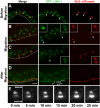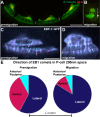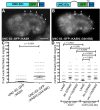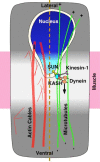Nuclei migrate through constricted spaces using microtubule motors and actin networks in C. elegans hypodermal cells
- PMID: 27697906
- PMCID: PMC5117218
- DOI: 10.1242/dev.141192
Nuclei migrate through constricted spaces using microtubule motors and actin networks in C. elegans hypodermal cells
Abstract
Cellular migrations through constricted spaces are a crucial aspect of many developmental and disease processes including hematopoiesis, inflammation and metastasis. A limiting factor in these events is nuclear deformation. Here, we establish an in vivo model in which nuclei can be visualized while moving through constrictions and use it to elucidate mechanisms for nuclear migration. C. elegans hypodermal P-cell larval nuclei traverse a narrow space that is about 5% their width. This constriction is blocked by fibrous organelles, structures that pass through P cells to connect the muscles to cuticle. Fibrous organelles are removed just prior to nuclear migration, when nuclei and lamins undergo extreme morphological changes to squeeze through the space. Both actin and microtubule networks are organized to mediate nuclear migration. The LINC complex, consisting of the SUN protein UNC-84 and the KASH protein UNC-83, recruits dynein and kinesin-1 to the nuclear surface. Both motors function in P-cell nuclear migration, but dynein, functioning through UNC-83, plays a more central role as nuclei migrate towards minus ends of polarized microtubule networks. Thus, the nucleoskeleton and cytoskeleton are coordinated to move nuclei through constricted spaces.
Keywords: C. elegans; Dynein; KASH; Nuclear migration; SUN.
© 2016. Published by The Company of Biologists Ltd.
Conflict of interest statement
The authors declare no competing or financial interests.
Figures








Similar articles
-
FLN-2 functions in parallel to linker of nucleoskeleton and cytoskeleton complexes and CDC-42/actin pathways during P-cell nuclear migration through constricted spaces in Caenorhabditis elegans.Genetics. 2024 Jul 8;227(3):iyae071. doi: 10.1093/genetics/iyae071. Genetics. 2024. PMID: 38797871 Free PMC article.
-
Kinesin-1 and dynein at the nuclear envelope mediate the bidirectional migrations of nuclei.J Cell Biol. 2010 Oct 4;191(1):115-28. doi: 10.1083/jcb.201004118. J Cell Biol. 2010. PMID: 20921138 Free PMC article.
-
UNC-83 is a nuclear-specific cargo adaptor for kinesin-1-mediated nuclear migration.Development. 2009 Aug;136(16):2725-33. doi: 10.1242/dev.038596. Epub 2009 Jul 15. Development. 2009. PMID: 19605495 Free PMC article.
-
Nuclear migration events throughout development.J Cell Sci. 2016 May 15;129(10):1951-61. doi: 10.1242/jcs.179788. J Cell Sci. 2016. PMID: 27182060 Free PMC article. Review.
-
ANChors away: an actin based mechanism of nuclear positioning.J Cell Sci. 2003 Jan 15;116(Pt 2):211-6. doi: 10.1242/jcs.00248. J Cell Sci. 2003. PMID: 12482907 Review.
Cited by
-
Actin and CDC-42 contribute to nuclear migration through constricted spaces in C. elegans.Development. 2023 Oct 1;150(19):dev202115. doi: 10.1242/dev.202115. Epub 2023 Oct 11. Development. 2023. PMID: 37756590 Free PMC article.
-
FLN-2 functions in parallel to linker of nucleoskeleton and cytoskeleton complexes and CDC-42/actin pathways during P-cell nuclear migration through constricted spaces in Caenorhabditis elegans.Genetics. 2024 Jul 8;227(3):iyae071. doi: 10.1093/genetics/iyae071. Genetics. 2024. PMID: 38797871 Free PMC article.
-
A network of nuclear envelope proteins and cytoskeletal force generators mediates movements of and within nuclei throughout Caenorhabditis elegans development.Exp Biol Med (Maywood). 2019 Nov;244(15):1323-1332. doi: 10.1177/1535370219871965. Epub 2019 Sep 7. Exp Biol Med (Maywood). 2019. PMID: 31495194 Free PMC article. Review.
-
Conserved SUN-KASH Interfaces Mediate LINC Complex-Dependent Nuclear Movement and Positioning.Curr Biol. 2018 Oct 8;28(19):3086-3097.e4. doi: 10.1016/j.cub.2018.08.001. Epub 2018 Sep 20. Curr Biol. 2018. PMID: 30245107 Free PMC article.
-
Caenorhabditis elegans LET-413 Scribble is essential in the epidermis for growth, viability, and directional outgrowth of epithelial seam cells.PLoS Genet. 2021 Oct 21;17(10):e1009856. doi: 10.1371/journal.pgen.1009856. eCollection 2021 Oct. PLoS Genet. 2021. PMID: 34673778 Free PMC article.
References
-
- Altun Z. F. and Hall D. H. (2009a). Epithelial system, hypodermis. WormAtlas, doi:10.3908/wormatlas.1.13 10.3908/wormatlas.1.13 - DOI
-
- Altun Z. F. and Hall D. H. (2009b). Muscle system, somatic muscle. WormAtlas, doi:10.3908/wormatlas.1.7 10.3908/wormatlas.1.7 - DOI
Publication types
MeSH terms
Substances
Grants and funding
LinkOut - more resources
Full Text Sources
Other Literature Sources
Research Materials

